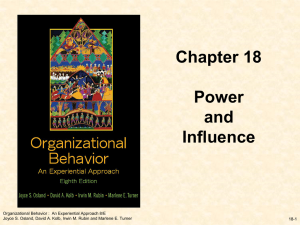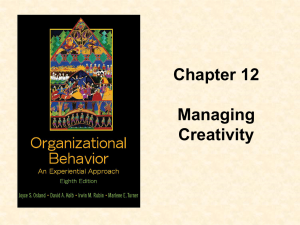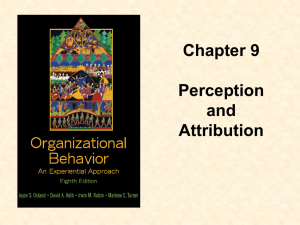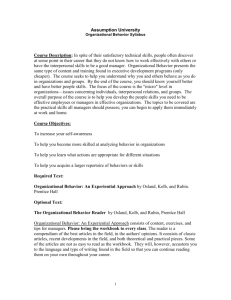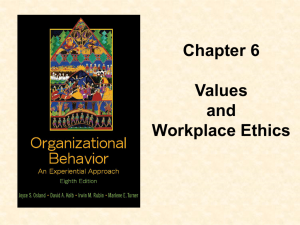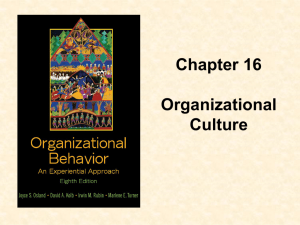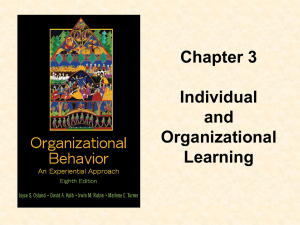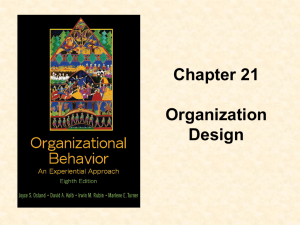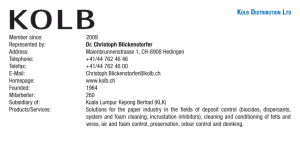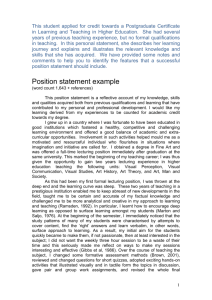Interpersonal Communication
advertisement
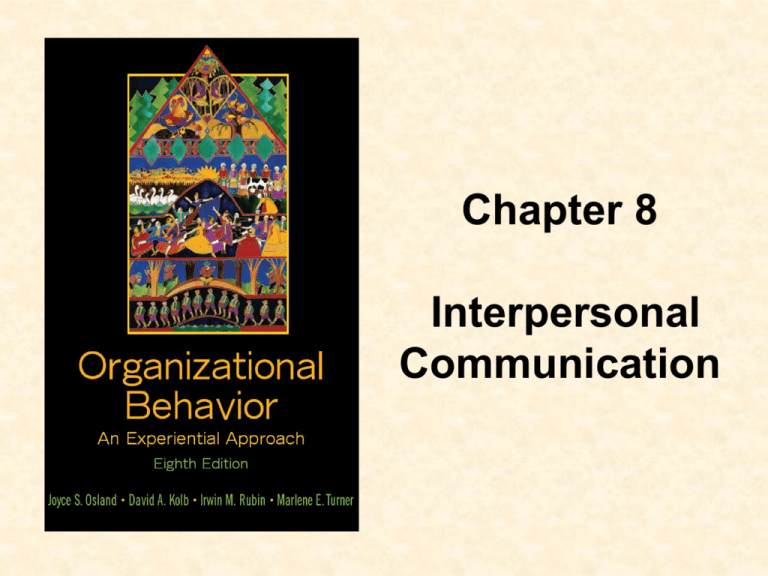
Chapter 8 Interpersonal Communication Objectives Understand the transactional model of communication List common sources of distortion in communication Identify gender differences in communication Identify cultural differences in communication Describe and identify the five response styles Organizational Behavior: An Experiential Approach 8/E Joyce S. Osland, David A. Kolb, Irwin M. Rubin and Marlene E. Turner 8 -1 …Objectives Explain how to create a non-defensive communication climate Recognize assertive communication and utilize I-statements Improve your active listening skills Organizational Behavior: An Experiential Approach 8/E Joyce S. Osland, David A. Kolb, Irwin M. Rubin and Marlene E. Turner 8 -2 Communication - Defined Communication is the process by which information is exchanged between communicators with the goal of achieving mutual understanding Organizational Behavior: An Experiential Approach 8/E Joyce S. Osland, David A. Kolb, Irwin M. Rubin and Marlene E. Turner 8 -3 Transactional Model of Communication A’s Field of Experience Shared Field of Experience and Symbolic Interactions over Time Communicator A Noise Communicator B Organizational Behavior: An Experiential Approach 8/E Joyce S. Osland, David A. Kolb, Irwin M. Rubin and Marlene E. Turner B’s Field of Experience 8 -4 Noise - Defined Noise is anything that interferes with the intended communication Three types of noise: Environmental Physiological Emotional Organizational Behavior: An Experiential Approach 8/E Joyce S. Osland, David A. Kolb, Irwin M. Rubin and Marlene E. Turner Noise 8 -5 Arc of Distortion A Sender What A intends to communicate Organizational Behavior: An Experiential Approach 8/E Joyce S. Osland, David A. Kolb, Irwin M. Rubin and Marlene E. Turner B Receiver 8 -6 Sources of Distortion Barriers to Communication Poor relationships Lack of clarity Individual differences in encoding/decoding Gender Perception Organizational Behavior: An Experiential Approach 8/E Joyce S. Osland, David A. Kolb, Irwin M. Rubin and Marlene E. Turner 8 -7 …Sources of Distortion Barriers to Communication Culture Misinterpretation of nonverbal communication Defensiveness Lack of feedback and clarification Poor listening skills Organizational Behavior: An Experiential Approach 8/E Joyce S. Osland, David A. Kolb, Irwin M. Rubin and Marlene E. Turner 8 -8 Meaning Lies in People not Words People are unique so they encode and decode messages differently Only 7% of meaning comes from words – 55% comes from facial expressions and posture and 38% from vocal intonation and inflection Words have different connotations for different groups Organizational Behavior: An Experiential Approach 8/E Joyce S. Osland, David A. Kolb, Irwin M. Rubin and Marlene E. Turner 8 -9 Gender Differences in Communication Women Men Concern: connect Maintain relationships Seek and give confirmation and support Aim for consensus When arguing, ask more questions and agree more; challenge less Concern: status Being one up/not one down Aim for dominance Gender Role Stereotypes Organizational Behavior: An Experiential Approach 8/E Joyce S. Osland, David A. Kolb, Irwin M. Rubin and Marlene E. Turner 8 -10 Gender Differences and Power Men and people of high status talk more than women and people of low status In formal meetings, men are more likely to: gain and keep the floor for more time, regardless of status interrupt others But some women control the topic in powerful positions redefine what women say also interrupt others Organizational Behavior: An Experiential Approach 8/E Joyce S. Osland, David A. Kolb, Irwin M. Rubin and Marlene E. Turner 8 -11 Women Are More Likely To... Be interrupted when they speak Use qualifiers (maybe, perhaps, sort of) Use disclaimers (I’m not really sure…) Phrase orders politely Frame orders as questions Use intensifiers Organizational Behavior: An Experiential Approach 8/E Joyce S. Osland, David A. Kolb, Irwin M. Rubin and Marlene E. Turner 8 -12 Cultural Communication Styles Low versus high context Direct versus indirect Self-enhancement versus self-effacement Use of silence and nonverbal gestures Organizational Behavior: An Experiential Approach 8/E Joyce S. Osland, David A. Kolb, Irwin M. Rubin and Marlene E. Turner 8 -13 Low Vs. High Context Low-Context Relies on explicit verbal messages Onus on sender to craft and transmit a clear message Found in individualistic cultures Organizational Behavior: An Experiential Approach 8/E Joyce S. Osland, David A. Kolb, Irwin M. Rubin and Marlene E. Turner High-Context Relies on information in the physical context or internalized in the person Onus on listener to “read” meaning into message Found in collectivist cultures 8 -14 Direct Vs. Indirect Direct Explicit messages Forthright tone of voice Organizational Behavior: An Experiential Approach 8/E Joyce S. Osland, David A. Kolb, Irwin M. Rubin and Marlene E. Turner Indirect Implicit/camouflaged messages Verbal statements hide speaker’s meaning 8 -15 Self-enhancement Vs. Self-effacement Self-enhancement Boast about accomplishments and abilities Organizational Behavior: An Experiential Approach 8/E Joyce S. Osland, David A. Kolb, Irwin M. Rubin and Marlene E. Turner Self-effacement Emphasize humility Modest talk Verbal restraints Hesitations Self-deprecation 8 -16 Silence and Nonverbal Gesture Interpreted differently across cultures: Silence Respect Disapproval Harmony Lack of understanding Nonverbal gestures Body movements Facial expressions Tone of voice Organizational Behavior: An Experiential Approach 8/E Joyce S. Osland, David A. Kolb, Irwin M. Rubin and Marlene E. Turner 8 -17 Response Styles Evaluative Interpretive Supportive Probing Understanding Organizational Behavior: An Experiential Approach 8/E Joyce S. Osland, David A. Kolb, Irwin M. Rubin and Marlene E. Turner 8 -18 Defensive/Non-defensive Communication Climates Defensive Climates Evaluation Control Strategy Neutrality Superiority Certainty Organizational Behavior: An Experiential Approach 8/E Joyce S. Osland, David A. Kolb, Irwin M. Rubin and Marlene E. Turner Supportive Climates Description Problem orientation Spontaneity Empathy Equality Provisionalism 8 -19 Assertiveness Defined The ability to communicate clearly and directly what you need or want Nonassert ive----Assertive----Aggressive (No influenc e) (Positive (Negative influenc e) influenc e) Organizational Behavior: An Experiential Approach 8/E Joyce S. Osland, David A. Kolb, Irwin M. Rubin and Marlene E. Turner 8 -20 I-Statements Behavio r Effect Feeling Organizational Behavior: An Experiential Approach 8/E Joyce S. Osland, David A. Kolb, Irwin M. Rubin and Marlene E. Turner 8 -21 I-Statements When you come late to class, it disrupts what’s going on and we have to stop to orient you and figure out what group you should join – and that’s annoying Organizational Behavior: An Experiential Approach 8/E Joyce S. Osland, David A. Kolb, Irwin M. Rubin and Marlene E. Turner 8 -22 Congruent Communication Thoughts Organizational Behavior: An Experiential Approach 8/E Joyce S. Osland, David A. Kolb, Irwin M. Rubin and Marlene E. Turner Feelings 8 -23 Active Listening Being non-evaluative Paraphrasing Reflecting implications Reflecting underlying feelings Inviting further contributions Using nonverbal response Organizational Behavior: An Experiential Approach 8/E Joyce S. Osland, David A. Kolb, Irwin M. Rubin and Marlene E. Turner 8 -24 Communication Channels Rich communication (multiple channels): Lean communication (limited channels): Verbal Visual Nonverbal Emotional e.g., face-to-face Language alone e.g., e-mail, emoticons Organizational Behavior: An Experiential Approach 8/E Joyce S. Osland, David A. Kolb, Irwin M. Rubin and Marlene E. Turner 8 -25
